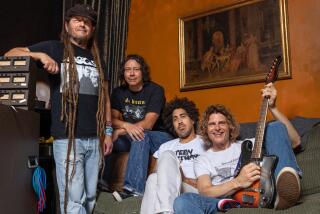Black Flag fans, after years of no band, now get two
No band from the nascent Los Angeles punk rock scene of the 1970s and ‘80s has meant more to subsequent hard-core generations than Black Flag. Few could have expected as much at the time.
“I’m totally surprised because we didn’t know what we were doing,” recalls Keith Morris, the band’s founding singer, who quit in 1979 to form his own early hard-core act, the Circle Jerks. “This is who we are, this is what we do: get in the room, turn the amps on and let it blast.”
Since the band’s breakup in 1986, fans and the curious have had to be content with all the “loudfastrules” recordings left behind, but this summer brings a strange new chapter: two competing versions of the band on tour.
PHOTOS: Iconic rock guitars and their owners
One is an official Black Flag reconvening with leader-guitarist Greg Ginn and singer Ron Reyes; the other a gathering of former group members simply called Flag, with Morris, bassist Chuck Dukowksi, guitarist-singer Dez Cadena and drummer Bill Stevenson.
It amounts to a lot of sudden activity for a punk brand mostly dormant for more than 25 years. That the factions were moved to form their own versions of the band in 2013 rather than join forces is a powerful sign of lingering estrangement between Ginn and certain key members from the band’s history.
“As genius of a guitar player as he is or was or is going to be — and Greg Ginn wrote some amazing songs — the amazing songs are only as amazing as the people that participate on the songs,” says Morris, 57, in T-shirt and jeans, dreadlocks past his shoulders.
The singer is in a Chinatown restaurant with Dukowski and Cadena, having a late lunch just steps away from the old Hong Kong Café site, an essential early L.A. punk rock venue. Black Flag performed several shows there at its beginnings, with Morris raging through “Wasted,” an early anthem of disaffected youth: “I was so-o-o-o wasted! I was a hippie, I was a burnout, I was a dropout, I was out of my head …”
Today, they’re discussing an unexpected future bringing that legacy back to the stage, performing material that helped define the SoCal hard-core sound. It was all about speed and confrontation then, an assault of noise and tales of madness, sex and death from the underside of American suburbia. Drawings of violence and dementia by the artist Raymond Pettibon (Ginn’s brother) on band record covers also set a bleak tone.
“We’re going to play the material the way it’s supposed to be played,” says Dukowski, 59, bearded and graying. “It’s going to be awesome.”
They acknowledge the strangeness of two versions of the same band hitting the road this year. Flag’s announced dates begin April 26 at the Monster Bash Festival in Munich, Germany, and include the Punk Rock Bowling and Music Festival in Las Vegas on May 27. Ginn’s Black Flag begins its tour May 15 in Luxembourg and arrives at the Observatory in Santa Ana July 12-13 and at Vex Arts in Los Angeles on July 14.
“Part of me wants to be angry, but it’s just not worth getting angry over,” says Morris, looking and sounding as energetic as always, despite a recent diabetic coma that caused the cancellation of tour dates with his other band, acclaimed modern hard-core act Off! “Ron’s my friend. I’m happy for him. As for Greg Ginn, that whole thing is a giant question mark.”
Neither Ginn nor Reyes would speak to The Times about their reconvening of Black Flag. According to the band’s publicist, Ginn “is retired from doing press” and has designated singer-pro skateboarder Mike Vallely as band spokesman. Vallely (a.k.a. Mike V.) is now the band’s co-manager and singer with another Ginn project, Good for You, which is opening for Black Flag on tour this summer.
“The band was always evolving; there was always people coming and going. The one constant member was always Greg,” insists Vallely, who compared any attempt to perform Black Flag material without the guitarist to “karaoke” and “Beatlemania.” “The people that left, a lot of times they left because of Greg.”
Ginn’s reunion with Reyes began at a 2010 celebration of the singer’s 50th birthday in Vancouver, Canada. Ginn joined him onstage, where they performed three songs together, and soon began talking about making new music. Aside from the 2013 tour, Ginn recently took his new lineup of Black Flag into the studio to record its first album of new material since 1985’s “In My Head.”
“He has a high level of activity,” says Vallely. “He’s constantly touring, constantly playing, constantly producing, writing and recording music.”
Among those curious to hear the new album is Joe Carducci, a former co-owner with Ginn of SST Records and author of “Rock and the Pop Narcotic,” a critical history of rock. “Greg has been doing instrumental music for all this time – decades,” says Carducci. “I just hope for his sake he’s got really good songs for Ron to sing, because he really can erase all of this too.”
Black Flag came out of Hermosa Beach and was initially welcomed with ambivalence by many within the Hollywood punk scene, with outright hostility coming from club owners alarmed by intense fan reaction. One by one, clubs banned Black Flag from their stages in the ‘80s.
“It was a tight scene, and we were from the beach — we were outsiders,” recalls Dukowski. “They didn’t know who we were. Once we started playing — it’s like a lot of things — once you get the ball rolling and then there’s momentum.”
For most of Black Flag’s first decade of existence, its members operated with total commitment to the cause, practicing several hours every day and living in a state of subterranean boho poverty. Black Flag’s first home was the Church, a former house of worship in the South Bay where the band rehearsed and some members lived in brotherly punk rock squalor.
In a 1986 interview with The Times, Ginn explained: “Black Flag isn’t a concept — it’s my total life.”
After Morris quit, Reyes was in the band for a brief but important period of six months, given even more significance by being the singer during the band’s appearance in the 1981 documentary “The Decline of Western Civilization.”
Band members came through, left a mark and then disappeared, often faster than Black Flag could release its music. Henry Rollins arrived in time to sing on the band’s landmark “Damaged” album in 1981 and remained until the breakup, but some songs on “Damaged” were originally sung by Morris with different lyrics. One song was called “Parents and Relatives” when performed by Morris, then “Video Disease” by Reyes, before finally seeing release as “Spray Paint” and sung by Rollins (with lyrics by Dukowski).
Rollins was the group’s longest-serving singer and in 2002 recorded a tribute album called “Rise Above: 24 Black Flag Songs to Benefit the West Memphis Three” with former band members and admirers from punk, metal and hip-hop. He was not available to comment on the dueling reunion acts.
Cadena’s exit from the band in 1983 was relatively peaceful. After stepping away from the microphone to his preferred position as second guitarist, Cadena finally bowed out completely simply because he wanted to start his own band. For the last 12 years, he has been guitarist for the Misfits.
Ginn was the only member to be part of every lineup, and as the band’s leader, it was ultimately his call to break up the band in 1986. Back in 1999, Morris discussed possibly working again with Ginn and met with the guitarist at a recording studio in Long Beach.
“I played him some of my songs, he played me some of his songs, and he told me that he’d call me back when I left,” Morris says. “And he never called me back.”
In 2003, Ginn organized a Black Flag reunion for two nights at the Hollywood Palladium for promoter Goldenvoice. Billed as a tribute to “The First Four Years,” it was Black Flag’s first live performance since the breakup, with a lineup that included Ginn, Cadena and drummer Robo. It was also notable for who wasn’t part of the show.
Morris was originally set to participate and attended two rehearsals with the guitarist. A falling out over many issues led to his departure. Reyes and Dukowski were also missing at the show.
Dukowski didn’t hear confirmation about the reunion until he called for roadside assistance for a dead car battery. “The guy rolled up and he realized who I was and broke out an LA Weekly with an ad for the show,” Dukowski remembers. “He said, ‘Would you autograph this?’ I said, sure, and I looked at it as I’m autographing it, and he goes, ‘I’m looking forward to it. Are you jamming?’ I said, ‘No, man. I’m learning about it from you.’”
Reactions to Ginn’s reunion concerts were wildly mixed, with some fans openly angry by the absence of certain personnel central to the band’s “first four years,” while others were thrilled for a chance to see and hear live Black Flag at all. One fan in the crowd was Foo Fighter Dave Grohl, whose first, self-made tattoo as a teen was an attempt of the band’s four-bar logo. (He managed to finish only three bars.)
“I walked in, and there was this skinhead standing against the wall just so … over it,” Grohl told The Times in 2011, “with this goth chick giving him a hickey. And I thought, ‘Oh, my God, it’s 1984, this is amazing.’ I thought it was great.”
Tickets for some Black Flag shows are already sold out, which is no surprise to Stewart Dean Ebersole, author of “Barred for Life,” a new book of interviews with band members and hardcore followers tattooed with the Black Flag logo. In the book are fans ages 18 to 51.
“Everybody really wants to go back to the roots, and here’s this band where you open the door and your head gets blown off,” says Ebersole of Black Flag’s original run, noting that the music was never anchored to a particular political moment, unlike some contemporaries. “That rage can run across the generations without it being, ‘Oh no, not another song about Ronald Reagan.’ They were attacking the personal versus the political from the get-go. They were basically saying, ‘It’s not the world, it’s me.’”
Morris and Dukowski finally got a chance to play those old Black Flag songs when the duo No Age invited them onstage during a July 2011 set at MacArthur Park. That same year, the singer and bassist appeared again at the Santa Monica Civic Auditorium for Goldenvoice’s 30th anniversary celebration with Stevenson and Descendents guitarist Stephen Egerton (now also a member of Flag) to perform the furious “Jealous Again” EP. It was all over in 10 minutes.
“We jumped up and did those songs,” says Morris. “The energy was so insane, so intense, it was undeniable. It would be ridiculous for us not to do this.”
Until the tour begins, the members of Flag will be reuniting with the material, practicing songs they haven’t played in many years.
“Playing an hour of this music is like running a mile. Maybe more,” says Dukowski with a smile. “I’m working out with the records. Every single day, I go through all of the songs and play them all. By the time we get in front of people, it’s going to be epic.”
PHOTOS AND MORE
COACHELLA: Complete 2013 lineup
THE ENVELOPE: Awards Insider
PHOTOS: Grammy top winners
More to Read
The biggest entertainment stories
Get our big stories about Hollywood, film, television, music, arts, culture and more right in your inbox as soon as they publish.
You may occasionally receive promotional content from the Los Angeles Times.











